-

Win a Free Custom Engraved Brass Coin!!!
As a way to introduce our brass coins to the community, we will raffle off a free coin during the month of August. Follow link ABOVE for instructions for entering.
You are using an out of date browser. It may not display this or other websites correctly.
You should upgrade or use an alternative browser.
You should upgrade or use an alternative browser.
I love this way of the messenger @modelshipbuilder65 made on his Royal Caroline in sacle 1:30
1/30 HMS Royal Caroline Build
I highly recommend this book because it has multiple drawings & information from actual sailors. A gold mine of information!!!! THANK YOU!!! I have this book, but have failed to use it very often as it is from the 19th century and I usually work with earlier period ships. Still, this book...
shipsofscale.com
- Joined
- Jul 27, 2021
- Messages
- 406
- Points
- 323

It's hawser rope.
i believe its rope too.
someone posted "how anchors are brought up" with some jaw dropping details and documentation of the entire processs. i think i saved it and will post the link.
here ya go... enjoy
someone posted "how anchors are brought up" with some jaw dropping details and documentation of the entire processs. i think i saved it and will post the link.
here ya go... enjoy
Bring Up the Anchor on a Ship of the Line
Interesting nice video with detailed explanations: A coloured schematic diagram on two joined sheets showing the inboard operations involved in hoisting anchor and stowing the cable on a British warship. It probably dates to the 1790s based on the dress of the Marines being used, as...
shipsofscale.com
Time is running - yes I posted it once - I forgot about itsomeone posted "how anchors are brought up" .....
So it was a "normal" rope and definitely no cable - interesting that it is called everywhere "messenger cable"
so a "normal" 3-strands right-handed rope ropeIt's hawser rope.
Once I made a screen shot of a video showing in the dark the anchor cable and the messenger of the HMS Victory
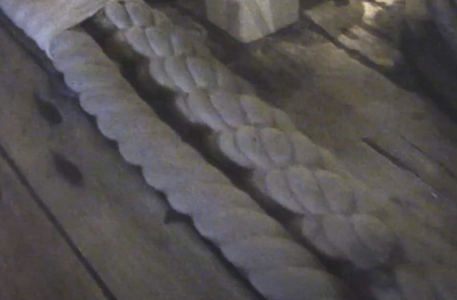
hahahaha yes it was you that posted that fact packed thread... i booked marked it because it was so informative. i also sent it to a few friends, not modelers but know it alls, that loved it.
- Joined
- Jul 27, 2021
- Messages
- 406
- Points
- 323

interesting that it is called everywhere "messenger cable"
It's the messenger for the cable ;-)
cheers Dirk
- Joined
- Jul 27, 2021
- Messages
- 406
- Points
- 323

In #5 is the anchor cable and the messenger rope shown. Cable would be not appropriate for a messenger, way to stiff.
Dirk
Dirk
Both the anchor cable and messenger are cable laid rope. From David Steel - cables are ropes made of nine strands that are nine inches and upwards in circumference. Cablets are cable-laid ropes, under nine inches in circumference. From James Lees' The Masting and Rigging of English Ships of War page 188, for the sheet and bower anchors the circumference of the cable is 0.62 X the diameter of the main mast. The circumference of the messenger is 0.75 X the circumference of the main stay. Hope this helps.
Allan
Allan
- Joined
- Jul 27, 2021
- Messages
- 406
- Points
- 323

I stand corrected, Allan is right it's a cablet.
Edit: I should read my own papers :-D
Dirk
Edit: I should read my own papers :-D
Dirk
Last edited:
Many Thanks for your assistance and the given information
and how a cablet is looking like?
When I read:
Cablets are cable-laid ropes, under nine inches in circumference
it means, that it is cable laid, but only smaller in diameter - but than it would look like the anchor cable only smaller in diameter
and the photo of the Victory messenger shows a cable which is preserved with parceling?
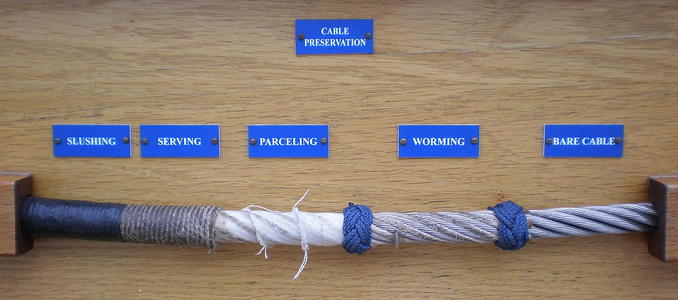
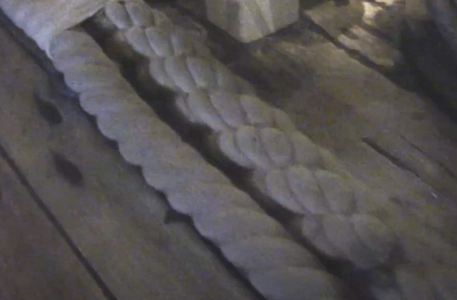
and how a cablet is looking like?
When I read:
Cablets are cable-laid ropes, under nine inches in circumference
it means, that it is cable laid, but only smaller in diameter - but than it would look like the anchor cable only smaller in diameter
and the photo of the Victory messenger shows a cable which is preserved with parceling?


- Joined
- Jul 27, 2021
- Messages
- 406
- Points
- 323

it means, that it is cable laid, but only smaller in diameter
Yes. This time I am sure
Dirk
Technically, I think the Granado should have a Viol cable, not a Messenger cable. I posted this in your excellent informational thread concerning the Granado HERE. I had posted this in your excellent reference topic on the Granado:Hallo all - I have a question where I am not 100% sure.
I want to install on my Granado a messenger cable to lift the anchor
Is a "messenger" a cable or a rope?
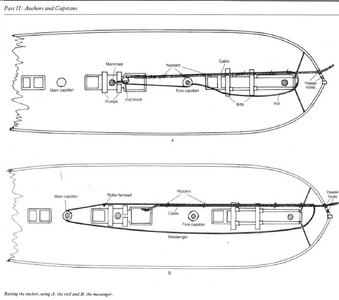
As to the answer to your question, I am assuming it is a rope. That does pose the question, however: why is the Viol or Messenger cable not as strong as the
 cable?
cable?The messenger only has to lift the anchor and anchor rope. The cable has to be able to stand the forces the ship and tides and wind puts on it.
Ah, yes, I guess that is the "retired" part of my being an engineer. Good catch.The messenger only has to lift the anchor and anchor rope. The cable has to be able to stand the forces the ship and tides and wind puts on it.
Yes you are correct with the correct term "viol" and not messengerTechnically, I think the Granado should have a Viol cable, not a Messenger cable. I posted this in your excellent informational thread concerning the Granado HERE. I had posted this in your excellent reference topic on the Granado:
View attachment 462611
As to the answer to your question, I am assuming it is a rope. That does pose the question, however: why is the Viol or Messenger cable not as strong as thecable?
The princip is more or less the same, only that the cable is redirected via this viol-block
I made some photos of the Goodwin book, which is showing in some details the model build by Lightley
The viol blocks fixed at the mortar house
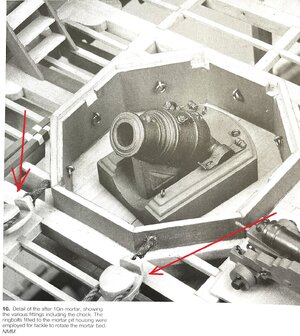
The two viol cables are running through these blocks
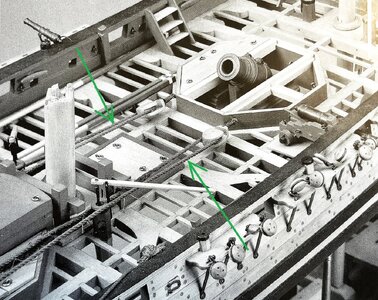
the anchor cables (blue arrows) are going over the
the viol cables (green arrows) are turned three or four times around the

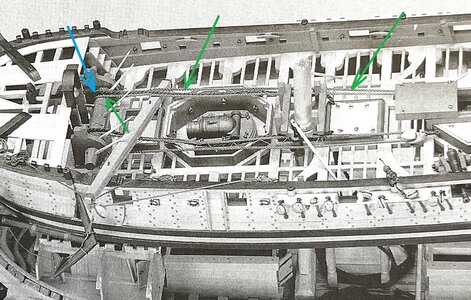
And both viol cables are connected with its anchor cable via the nippers
-> so it seems, that in moment, based by this arrangement, both anchors are lifted
So far everything understood ( I think)
But this is not fitting to the anchor arrangement, or?
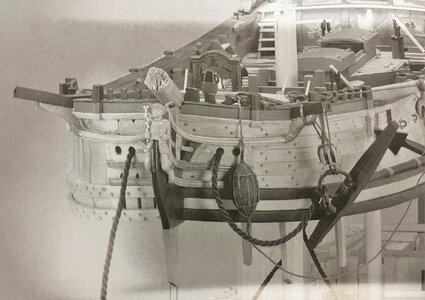
Unfortunately Goodwin is not showing or describing anything related to this in his anatomy book
I am thinking in moment:
1) How would be the cable arrangement during achorage ?
I guess without the viol-cable and the anchor cable somehow arround a main bitt and fixed with some nippers towards the deck (eyebolts) or something similar
2) During the lifting action I guess like shown in the Lightley model
3) stored anchor during sailing ?
Not so easy when you do not have a "normal" ship .........
Last edited:
Is the viol only used with a windlass and the messenger only used with a capstan? Or is that too generalized?
you see at the sketch posted by @SignetIs the viol only used with a windlass and the messenger only used with a capstan? Or is that too generalized?
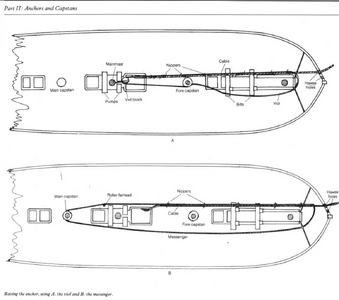
that a viol can also be used with a capstan and not only via a windlass
I'm not sure what in the above photo is not consistent with the viol-cable system.
That is what I would assume as well.Unfortunately Goodwin is not showing or describing anything related to this in his anatomy book
I am thinking in moment:
1) How would be the cable arrangement during achorage ?
I guess without the viol-cable and the anchor cable somehow arround a main bitt and fixed with some nippers towards the deck (eyebolts) or something similar
Yes, I think.2) During the lifting action I guess like shown in the Lightley model
I would expect the anchor cable still to be around the main bitt, in case it broke loose during a storm or something. Probably one or more nippers to eyebolts as well, in preparation for lowering it.3) stored anchor during sailing ?
Very true, and the Granado is anything but "normal". I've always wondered about the rope attached to the anchor buoy. Most models I've seen show very little rope coiled between the buoy and the anchor. Yet would it not need sufficient rope for use when the anchor cable is fully extended to its length of 120 fathoms? Current boating anchor standards recommend an anchor scope of 7:1, which means an anchor cable length of 7 times the water depth. But that would still mean an anchor buoy rope approaching 100 feet in length (2 actual feet on our model). That's a lot of rope to coil up! Perhaps they kept the rope short, and added to it if necessary?Not so easy when you do not have a "normal" ship .........






